Prevention of Pneumonia in the Elderly
VerifiedAdded on 2022/12/26
|7
|1878
|83
AI Summary
This article discusses the prevention of pneumonia in the elderly population. It covers the symptoms, causes, and treatment options for pneumonia in older adults. The impact of pneumonia on the geriatric population is also explored.
Contribute Materials
Your contribution can guide someone’s learning journey. Share your
documents today.
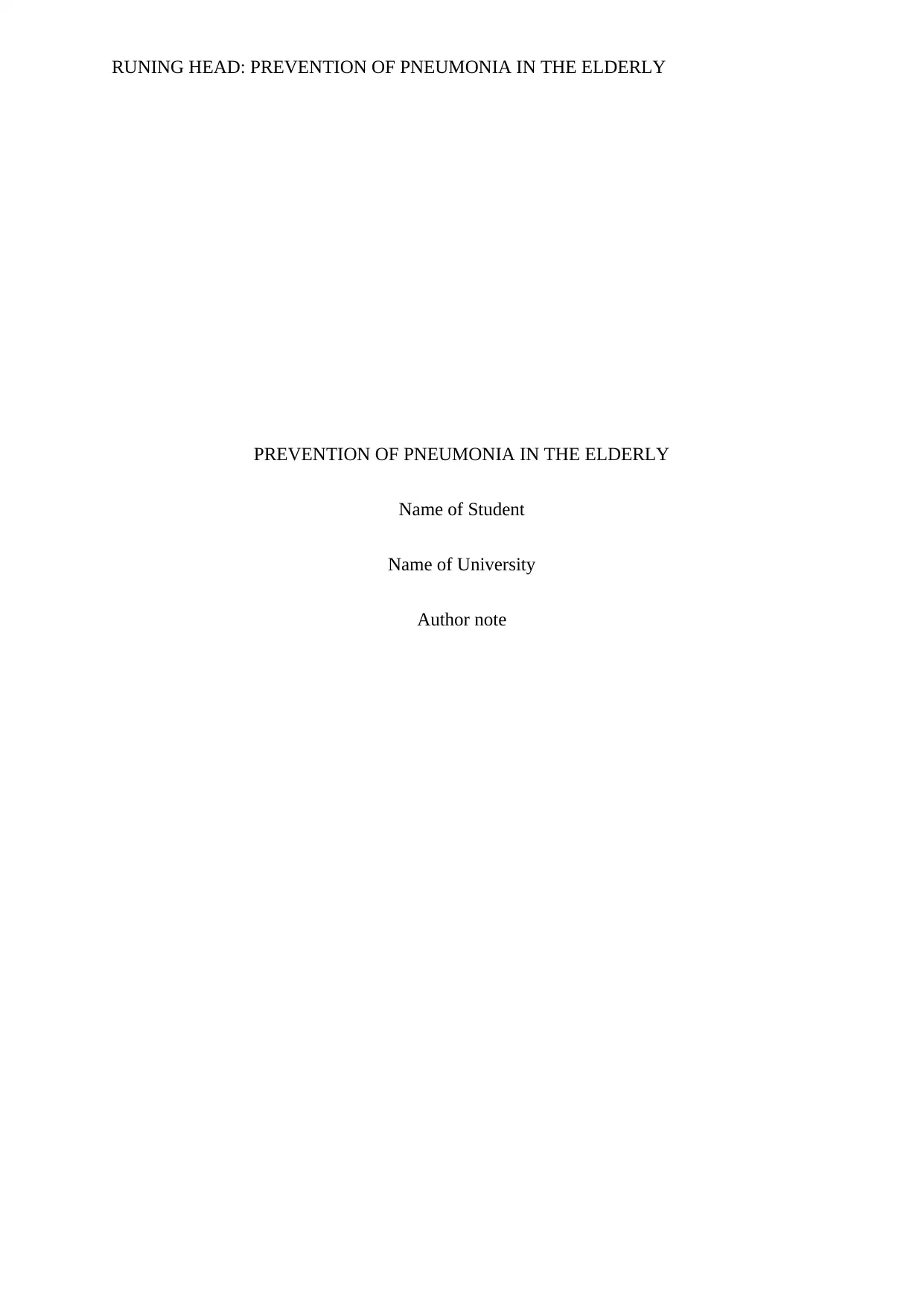
RUNING HEAD: PREVENTION OF PNEUMONIA IN THE ELDERLY
PREVENTION OF PNEUMONIA IN THE ELDERLY
Name of Student
Name of University
Author note
PREVENTION OF PNEUMONIA IN THE ELDERLY
Name of Student
Name of University
Author note
Secure Best Marks with AI Grader
Need help grading? Try our AI Grader for instant feedback on your assignments.
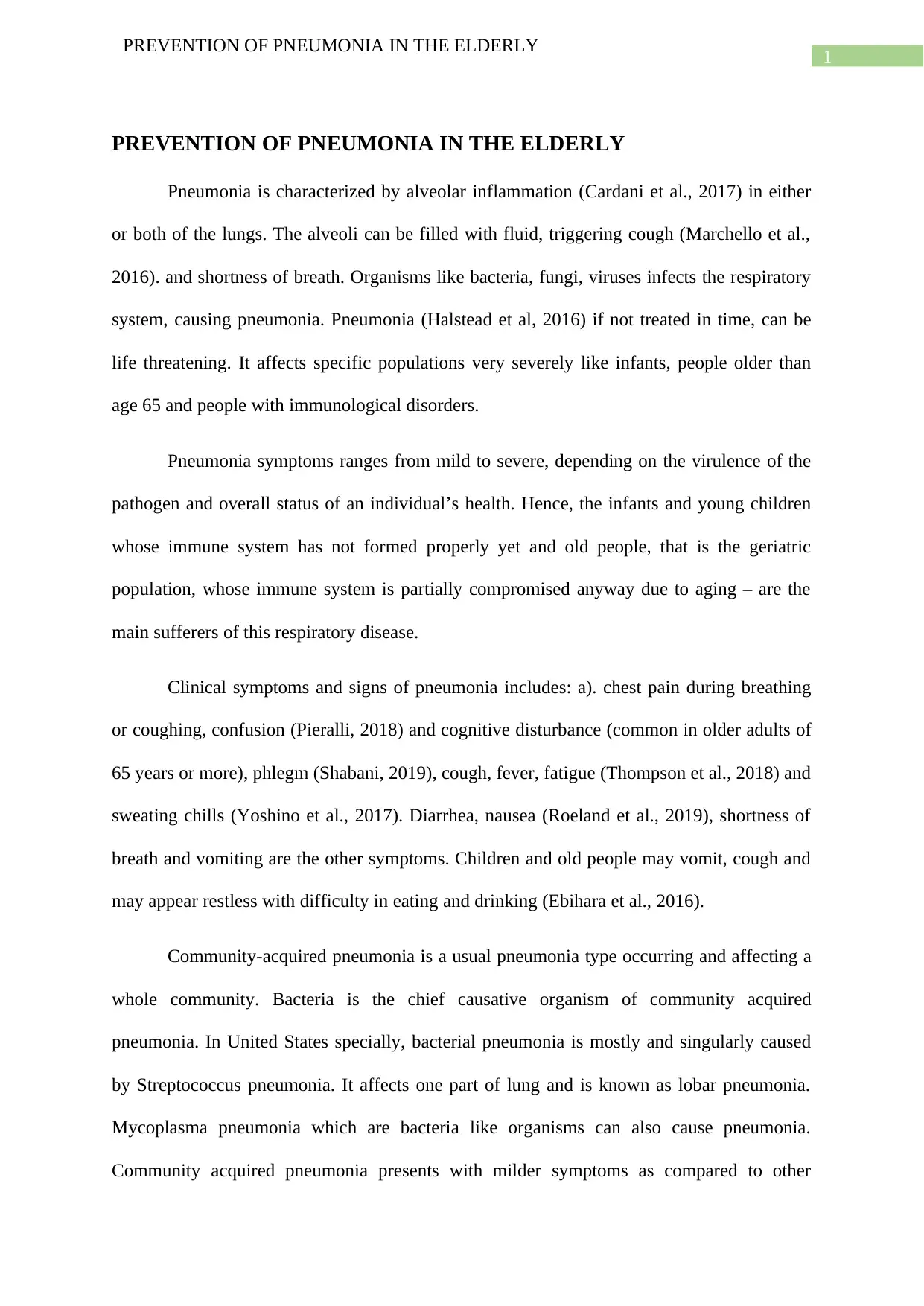
1
PREVENTION OF PNEUMONIA IN THE ELDERLY
PREVENTION OF PNEUMONIA IN THE ELDERLY
Pneumonia is characterized by alveolar inflammation (Cardani et al., 2017) in either
or both of the lungs. The alveoli can be filled with fluid, triggering cough (Marchello et al.,
2016). and shortness of breath. Organisms like bacteria, fungi, viruses infects the respiratory
system, causing pneumonia. Pneumonia (Halstead et al, 2016) if not treated in time, can be
life threatening. It affects specific populations very severely like infants, people older than
age 65 and people with immunological disorders.
Pneumonia symptoms ranges from mild to severe, depending on the virulence of the
pathogen and overall status of an individual’s health. Hence, the infants and young children
whose immune system has not formed properly yet and old people, that is the geriatric
population, whose immune system is partially compromised anyway due to aging – are the
main sufferers of this respiratory disease.
Clinical symptoms and signs of pneumonia includes: a). chest pain during breathing
or coughing, confusion (Pieralli, 2018) and cognitive disturbance (common in older adults of
65 years or more), phlegm (Shabani, 2019), cough, fever, fatigue (Thompson et al., 2018) and
sweating chills (Yoshino et al., 2017). Diarrhea, nausea (Roeland et al., 2019), shortness of
breath and vomiting are the other symptoms. Children and old people may vomit, cough and
may appear restless with difficulty in eating and drinking (Ebihara et al., 2016).
Community-acquired pneumonia is a usual pneumonia type occurring and affecting a
whole community. Bacteria is the chief causative organism of community acquired
pneumonia. In United States specially, bacterial pneumonia is mostly and singularly caused
by Streptococcus pneumonia. It affects one part of lung and is known as lobar pneumonia.
Mycoplasma pneumonia which are bacteria like organisms can also cause pneumonia.
Community acquired pneumonia presents with milder symptoms as compared to other
PREVENTION OF PNEUMONIA IN THE ELDERLY
PREVENTION OF PNEUMONIA IN THE ELDERLY
Pneumonia is characterized by alveolar inflammation (Cardani et al., 2017) in either
or both of the lungs. The alveoli can be filled with fluid, triggering cough (Marchello et al.,
2016). and shortness of breath. Organisms like bacteria, fungi, viruses infects the respiratory
system, causing pneumonia. Pneumonia (Halstead et al, 2016) if not treated in time, can be
life threatening. It affects specific populations very severely like infants, people older than
age 65 and people with immunological disorders.
Pneumonia symptoms ranges from mild to severe, depending on the virulence of the
pathogen and overall status of an individual’s health. Hence, the infants and young children
whose immune system has not formed properly yet and old people, that is the geriatric
population, whose immune system is partially compromised anyway due to aging – are the
main sufferers of this respiratory disease.
Clinical symptoms and signs of pneumonia includes: a). chest pain during breathing
or coughing, confusion (Pieralli, 2018) and cognitive disturbance (common in older adults of
65 years or more), phlegm (Shabani, 2019), cough, fever, fatigue (Thompson et al., 2018) and
sweating chills (Yoshino et al., 2017). Diarrhea, nausea (Roeland et al., 2019), shortness of
breath and vomiting are the other symptoms. Children and old people may vomit, cough and
may appear restless with difficulty in eating and drinking (Ebihara et al., 2016).
Community-acquired pneumonia is a usual pneumonia type occurring and affecting a
whole community. Bacteria is the chief causative organism of community acquired
pneumonia. In United States specially, bacterial pneumonia is mostly and singularly caused
by Streptococcus pneumonia. It affects one part of lung and is known as lobar pneumonia.
Mycoplasma pneumonia which are bacteria like organisms can also cause pneumonia.
Community acquired pneumonia presents with milder symptoms as compared to other
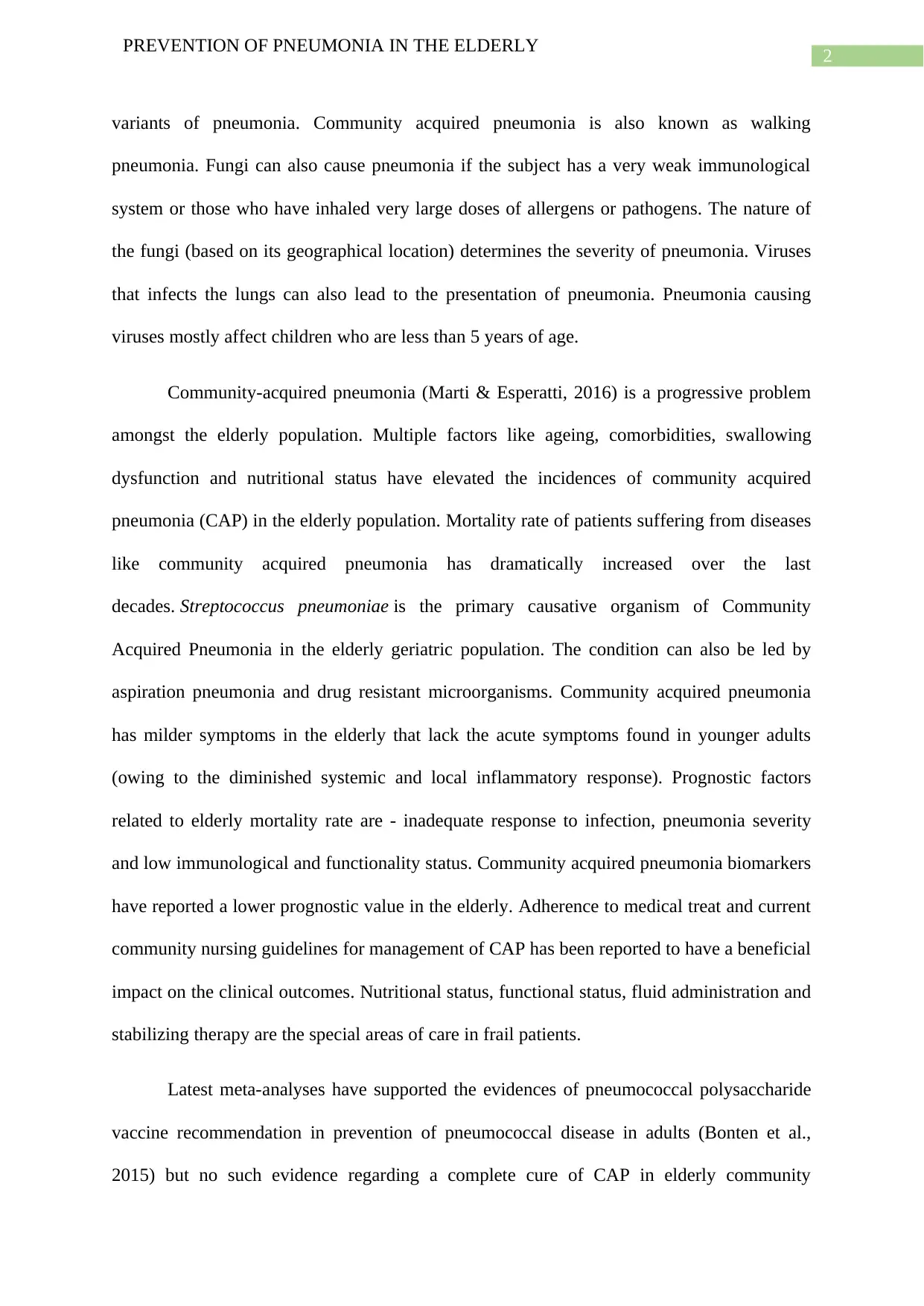
2
PREVENTION OF PNEUMONIA IN THE ELDERLY
variants of pneumonia. Community acquired pneumonia is also known as walking
pneumonia. Fungi can also cause pneumonia if the subject has a very weak immunological
system or those who have inhaled very large doses of allergens or pathogens. The nature of
the fungi (based on its geographical location) determines the severity of pneumonia. Viruses
that infects the lungs can also lead to the presentation of pneumonia. Pneumonia causing
viruses mostly affect children who are less than 5 years of age.
Community-acquired pneumonia (Marti & Esperatti, 2016) is a progressive problem
amongst the elderly population. Multiple factors like ageing, comorbidities, swallowing
dysfunction and nutritional status have elevated the incidences of community acquired
pneumonia (CAP) in the elderly population. Mortality rate of patients suffering from diseases
like community acquired pneumonia has dramatically increased over the last
decades. Streptococcus pneumoniae is the primary causative organism of Community
Acquired Pneumonia in the elderly geriatric population. The condition can also be led by
aspiration pneumonia and drug resistant microorganisms. Community acquired pneumonia
has milder symptoms in the elderly that lack the acute symptoms found in younger adults
(owing to the diminished systemic and local inflammatory response). Prognostic factors
related to elderly mortality rate are - inadequate response to infection, pneumonia severity
and low immunological and functionality status. Community acquired pneumonia biomarkers
have reported a lower prognostic value in the elderly. Adherence to medical treat and current
community nursing guidelines for management of CAP has been reported to have a beneficial
impact on the clinical outcomes. Nutritional status, functional status, fluid administration and
stabilizing therapy are the special areas of care in frail patients.
Latest meta-analyses have supported the evidences of pneumococcal polysaccharide
vaccine recommendation in prevention of pneumococcal disease in adults (Bonten et al.,
2015) but no such evidence regarding a complete cure of CAP in elderly community
PREVENTION OF PNEUMONIA IN THE ELDERLY
variants of pneumonia. Community acquired pneumonia is also known as walking
pneumonia. Fungi can also cause pneumonia if the subject has a very weak immunological
system or those who have inhaled very large doses of allergens or pathogens. The nature of
the fungi (based on its geographical location) determines the severity of pneumonia. Viruses
that infects the lungs can also lead to the presentation of pneumonia. Pneumonia causing
viruses mostly affect children who are less than 5 years of age.
Community-acquired pneumonia (Marti & Esperatti, 2016) is a progressive problem
amongst the elderly population. Multiple factors like ageing, comorbidities, swallowing
dysfunction and nutritional status have elevated the incidences of community acquired
pneumonia (CAP) in the elderly population. Mortality rate of patients suffering from diseases
like community acquired pneumonia has dramatically increased over the last
decades. Streptococcus pneumoniae is the primary causative organism of Community
Acquired Pneumonia in the elderly geriatric population. The condition can also be led by
aspiration pneumonia and drug resistant microorganisms. Community acquired pneumonia
has milder symptoms in the elderly that lack the acute symptoms found in younger adults
(owing to the diminished systemic and local inflammatory response). Prognostic factors
related to elderly mortality rate are - inadequate response to infection, pneumonia severity
and low immunological and functionality status. Community acquired pneumonia biomarkers
have reported a lower prognostic value in the elderly. Adherence to medical treat and current
community nursing guidelines for management of CAP has been reported to have a beneficial
impact on the clinical outcomes. Nutritional status, functional status, fluid administration and
stabilizing therapy are the special areas of care in frail patients.
Latest meta-analyses have supported the evidences of pneumococcal polysaccharide
vaccine recommendation in prevention of pneumococcal disease in adults (Bonten et al.,
2015) but no such evidence regarding a complete cure of CAP in elderly community
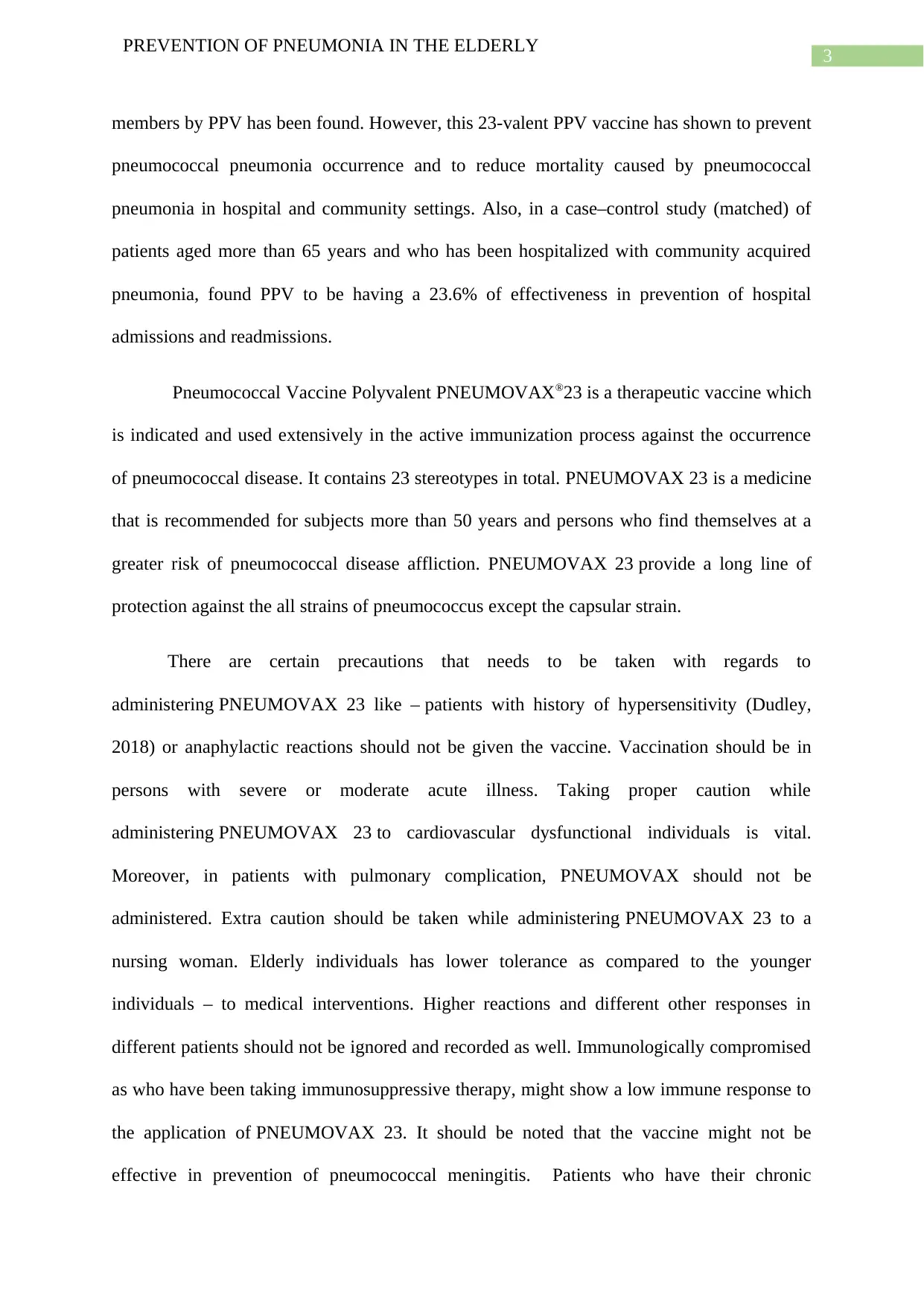
3
PREVENTION OF PNEUMONIA IN THE ELDERLY
members by PPV has been found. However, this 23-valent PPV vaccine has shown to prevent
pneumococcal pneumonia occurrence and to reduce mortality caused by pneumococcal
pneumonia in hospital and community settings. Also, in a case–control study (matched) of
patients aged more than 65 years and who has been hospitalized with community acquired
pneumonia, found PPV to be having a 23.6% of effectiveness in prevention of hospital
admissions and readmissions.
Pneumococcal Vaccine Polyvalent PNEUMOVAX®23 is a therapeutic vaccine which
is indicated and used extensively in the active immunization process against the occurrence
of pneumococcal disease. It contains 23 stereotypes in total. PNEUMOVAX 23 is a medicine
that is recommended for subjects more than 50 years and persons who find themselves at a
greater risk of pneumococcal disease affliction. PNEUMOVAX 23 provide a long line of
protection against the all strains of pneumococcus except the capsular strain.
There are certain precautions that needs to be taken with regards to
administering PNEUMOVAX 23 like – patients with history of hypersensitivity (Dudley,
2018) or anaphylactic reactions should not be given the vaccine. Vaccination should be in
persons with severe or moderate acute illness. Taking proper caution while
administering PNEUMOVAX 23 to cardiovascular dysfunctional individuals is vital.
Moreover, in patients with pulmonary complication, PNEUMOVAX should not be
administered. Extra caution should be taken while administering PNEUMOVAX 23 to a
nursing woman. Elderly individuals has lower tolerance as compared to the younger
individuals – to medical interventions. Higher reactions and different other responses in
different patients should not be ignored and recorded as well. Immunologically compromised
as who have been taking immunosuppressive therapy, might show a low immune response to
the application of PNEUMOVAX 23. It should be noted that the vaccine might not be
effective in prevention of pneumococcal meningitis. Patients who have their chronic
PREVENTION OF PNEUMONIA IN THE ELDERLY
members by PPV has been found. However, this 23-valent PPV vaccine has shown to prevent
pneumococcal pneumonia occurrence and to reduce mortality caused by pneumococcal
pneumonia in hospital and community settings. Also, in a case–control study (matched) of
patients aged more than 65 years and who has been hospitalized with community acquired
pneumonia, found PPV to be having a 23.6% of effectiveness in prevention of hospital
admissions and readmissions.
Pneumococcal Vaccine Polyvalent PNEUMOVAX®23 is a therapeutic vaccine which
is indicated and used extensively in the active immunization process against the occurrence
of pneumococcal disease. It contains 23 stereotypes in total. PNEUMOVAX 23 is a medicine
that is recommended for subjects more than 50 years and persons who find themselves at a
greater risk of pneumococcal disease affliction. PNEUMOVAX 23 provide a long line of
protection against the all strains of pneumococcus except the capsular strain.
There are certain precautions that needs to be taken with regards to
administering PNEUMOVAX 23 like – patients with history of hypersensitivity (Dudley,
2018) or anaphylactic reactions should not be given the vaccine. Vaccination should be in
persons with severe or moderate acute illness. Taking proper caution while
administering PNEUMOVAX 23 to cardiovascular dysfunctional individuals is vital.
Moreover, in patients with pulmonary complication, PNEUMOVAX should not be
administered. Extra caution should be taken while administering PNEUMOVAX 23 to a
nursing woman. Elderly individuals has lower tolerance as compared to the younger
individuals – to medical interventions. Higher reactions and different other responses in
different patients should not be ignored and recorded as well. Immunologically compromised
as who have been taking immunosuppressive therapy, might show a low immune response to
the application of PNEUMOVAX 23. It should be noted that the vaccine might not be
effective in prevention of pneumococcal meningitis. Patients who have their chronic
Secure Best Marks with AI Grader
Need help grading? Try our AI Grader for instant feedback on your assignments.
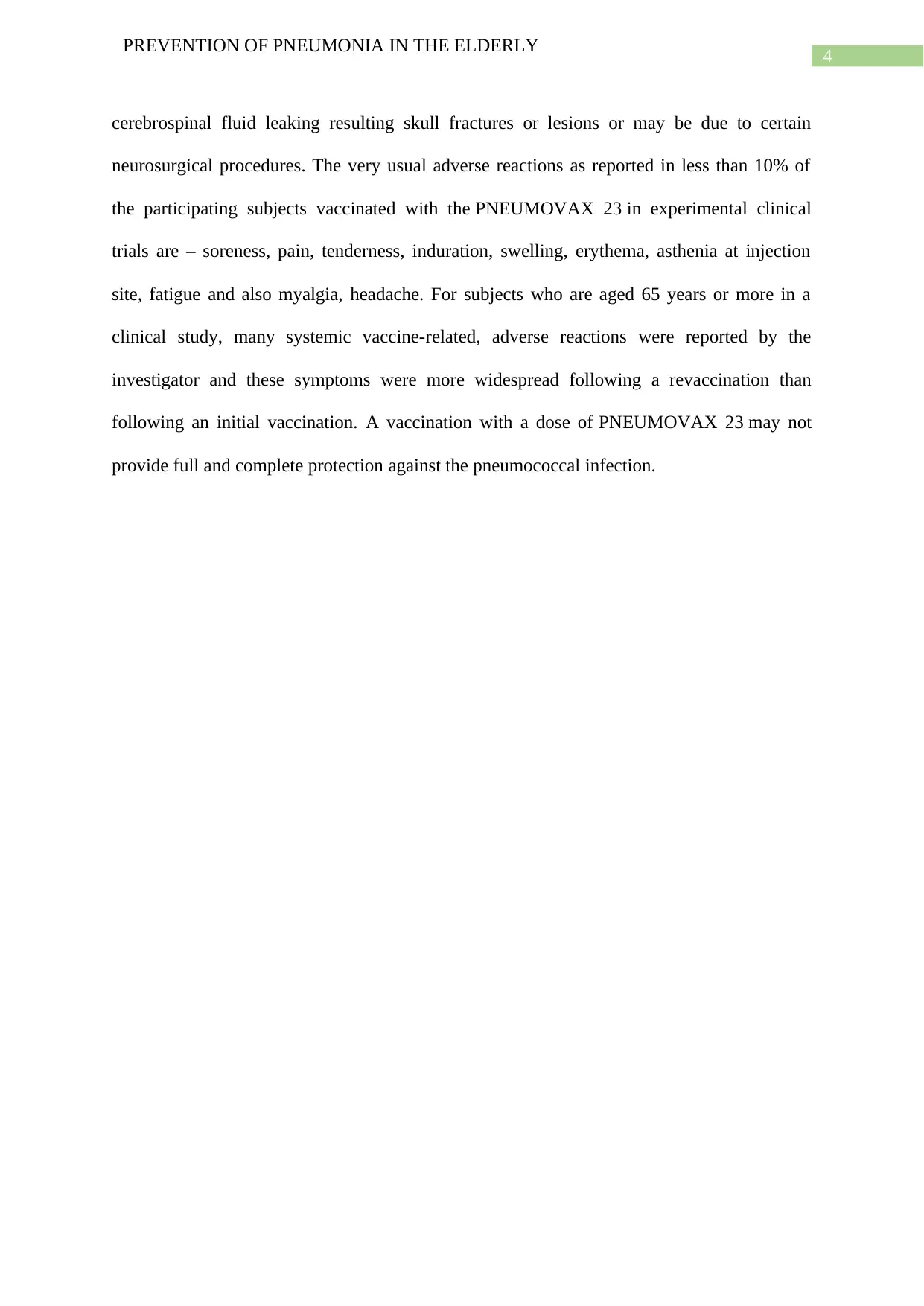
4
PREVENTION OF PNEUMONIA IN THE ELDERLY
cerebrospinal fluid leaking resulting skull fractures or lesions or may be due to certain
neurosurgical procedures. The very usual adverse reactions as reported in less than 10% of
the participating subjects vaccinated with the PNEUMOVAX 23 in experimental clinical
trials are – soreness, pain, tenderness, induration, swelling, erythema, asthenia at injection
site, fatigue and also myalgia, headache. For subjects who are aged 65 years or more in a
clinical study, many systemic vaccine-related, adverse reactions were reported by the
investigator and these symptoms were more widespread following a revaccination than
following an initial vaccination. A vaccination with a dose of PNEUMOVAX 23 may not
provide full and complete protection against the pneumococcal infection.
PREVENTION OF PNEUMONIA IN THE ELDERLY
cerebrospinal fluid leaking resulting skull fractures or lesions or may be due to certain
neurosurgical procedures. The very usual adverse reactions as reported in less than 10% of
the participating subjects vaccinated with the PNEUMOVAX 23 in experimental clinical
trials are – soreness, pain, tenderness, induration, swelling, erythema, asthenia at injection
site, fatigue and also myalgia, headache. For subjects who are aged 65 years or more in a
clinical study, many systemic vaccine-related, adverse reactions were reported by the
investigator and these symptoms were more widespread following a revaccination than
following an initial vaccination. A vaccination with a dose of PNEUMOVAX 23 may not
provide full and complete protection against the pneumococcal infection.
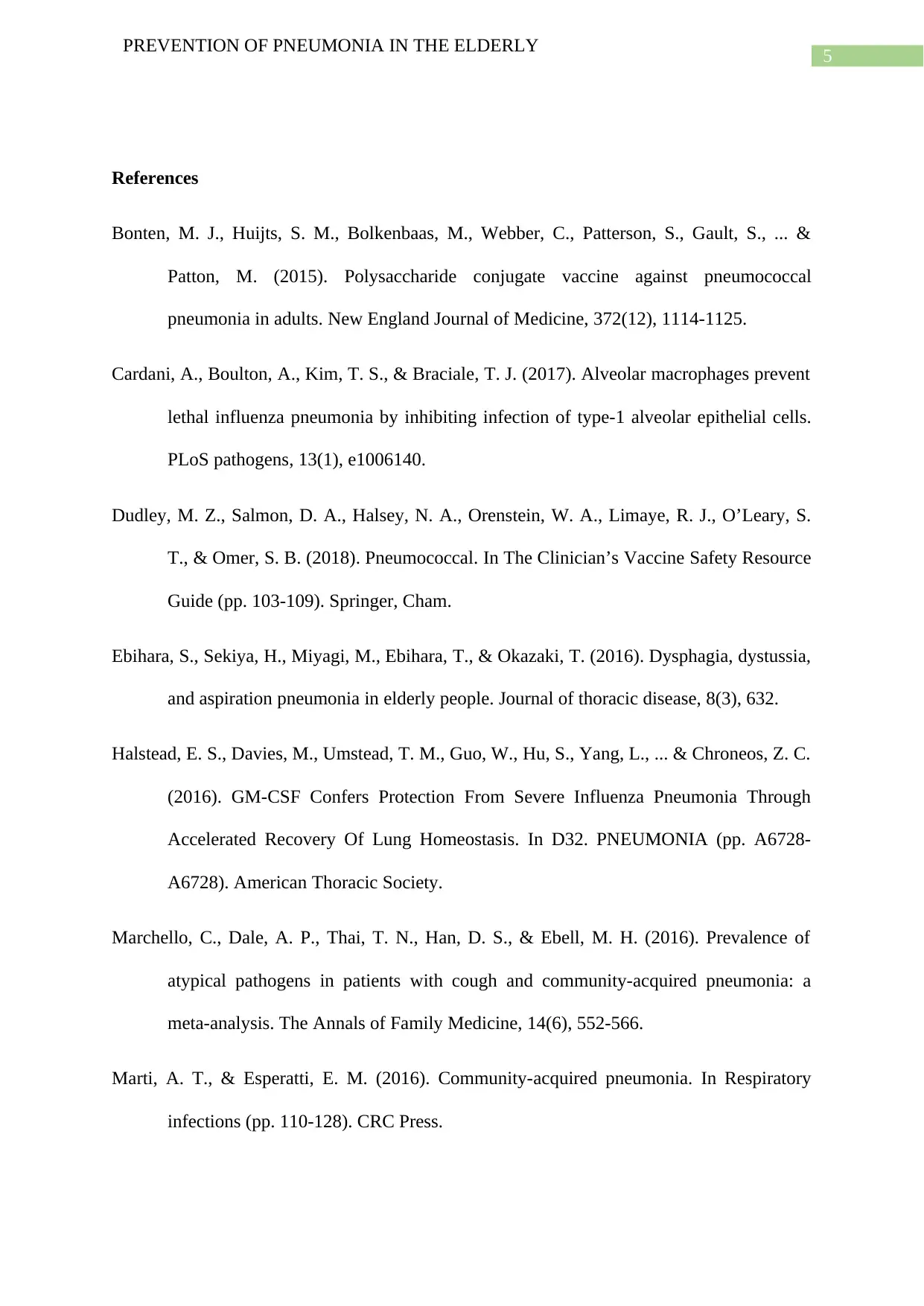
5
PREVENTION OF PNEUMONIA IN THE ELDERLY
References
Bonten, M. J., Huijts, S. M., Bolkenbaas, M., Webber, C., Patterson, S., Gault, S., ... &
Patton, M. (2015). Polysaccharide conjugate vaccine against pneumococcal
pneumonia in adults. New England Journal of Medicine, 372(12), 1114-1125.
Cardani, A., Boulton, A., Kim, T. S., & Braciale, T. J. (2017). Alveolar macrophages prevent
lethal influenza pneumonia by inhibiting infection of type-1 alveolar epithelial cells.
PLoS pathogens, 13(1), e1006140.
Dudley, M. Z., Salmon, D. A., Halsey, N. A., Orenstein, W. A., Limaye, R. J., O’Leary, S.
T., & Omer, S. B. (2018). Pneumococcal. In The Clinician’s Vaccine Safety Resource
Guide (pp. 103-109). Springer, Cham.
Ebihara, S., Sekiya, H., Miyagi, M., Ebihara, T., & Okazaki, T. (2016). Dysphagia, dystussia,
and aspiration pneumonia in elderly people. Journal of thoracic disease, 8(3), 632.
Halstead, E. S., Davies, M., Umstead, T. M., Guo, W., Hu, S., Yang, L., ... & Chroneos, Z. C.
(2016). GM-CSF Confers Protection From Severe Influenza Pneumonia Through
Accelerated Recovery Of Lung Homeostasis. In D32. PNEUMONIA (pp. A6728-
A6728). American Thoracic Society.
Marchello, C., Dale, A. P., Thai, T. N., Han, D. S., & Ebell, M. H. (2016). Prevalence of
atypical pathogens in patients with cough and community-acquired pneumonia: a
meta-analysis. The Annals of Family Medicine, 14(6), 552-566.
Marti, A. T., & Esperatti, E. M. (2016). Community-acquired pneumonia. In Respiratory
infections (pp. 110-128). CRC Press.
PREVENTION OF PNEUMONIA IN THE ELDERLY
References
Bonten, M. J., Huijts, S. M., Bolkenbaas, M., Webber, C., Patterson, S., Gault, S., ... &
Patton, M. (2015). Polysaccharide conjugate vaccine against pneumococcal
pneumonia in adults. New England Journal of Medicine, 372(12), 1114-1125.
Cardani, A., Boulton, A., Kim, T. S., & Braciale, T. J. (2017). Alveolar macrophages prevent
lethal influenza pneumonia by inhibiting infection of type-1 alveolar epithelial cells.
PLoS pathogens, 13(1), e1006140.
Dudley, M. Z., Salmon, D. A., Halsey, N. A., Orenstein, W. A., Limaye, R. J., O’Leary, S.
T., & Omer, S. B. (2018). Pneumococcal. In The Clinician’s Vaccine Safety Resource
Guide (pp. 103-109). Springer, Cham.
Ebihara, S., Sekiya, H., Miyagi, M., Ebihara, T., & Okazaki, T. (2016). Dysphagia, dystussia,
and aspiration pneumonia in elderly people. Journal of thoracic disease, 8(3), 632.
Halstead, E. S., Davies, M., Umstead, T. M., Guo, W., Hu, S., Yang, L., ... & Chroneos, Z. C.
(2016). GM-CSF Confers Protection From Severe Influenza Pneumonia Through
Accelerated Recovery Of Lung Homeostasis. In D32. PNEUMONIA (pp. A6728-
A6728). American Thoracic Society.
Marchello, C., Dale, A. P., Thai, T. N., Han, D. S., & Ebell, M. H. (2016). Prevalence of
atypical pathogens in patients with cough and community-acquired pneumonia: a
meta-analysis. The Annals of Family Medicine, 14(6), 552-566.
Marti, A. T., & Esperatti, E. M. (2016). Community-acquired pneumonia. In Respiratory
infections (pp. 110-128). CRC Press.
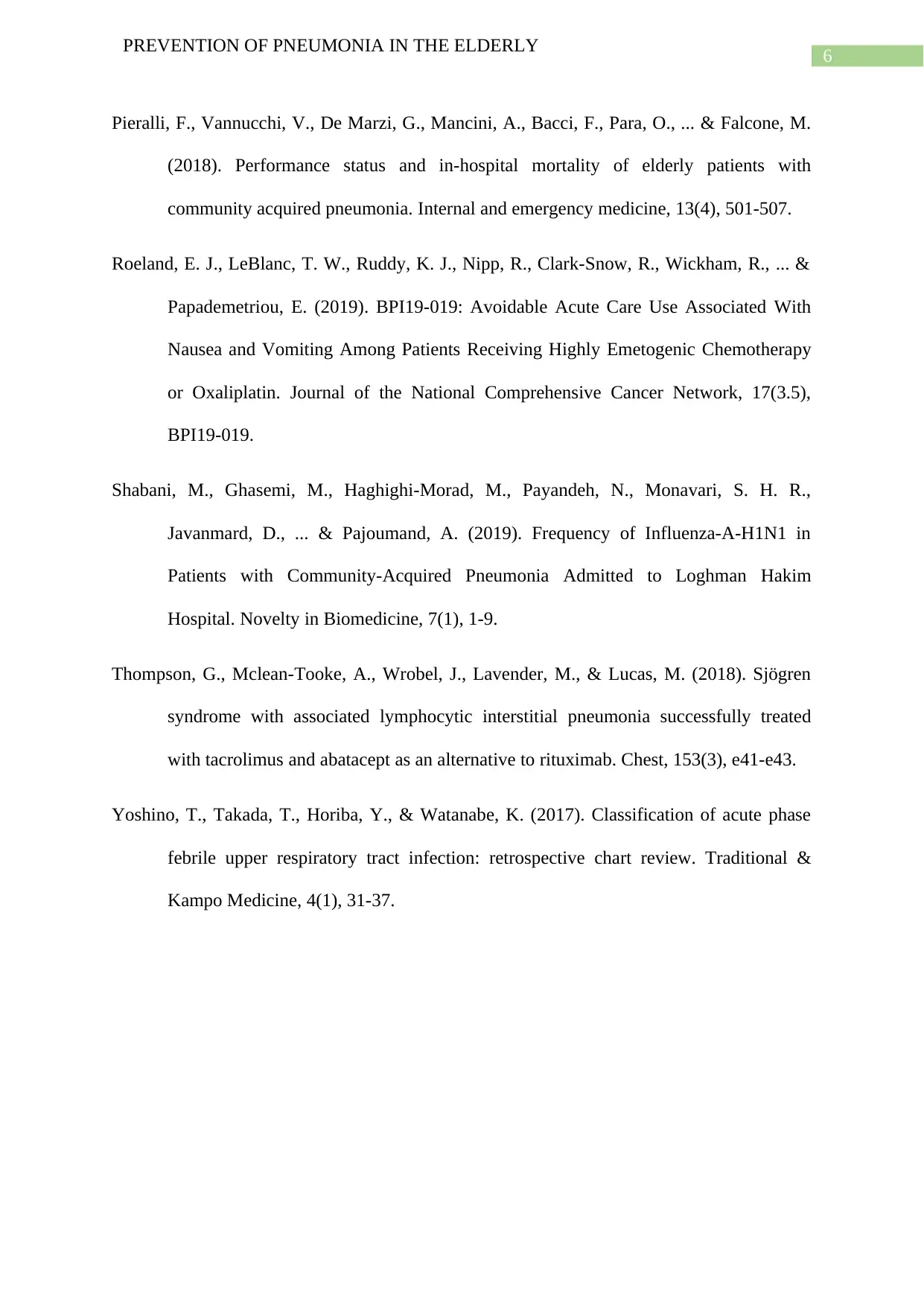
6
PREVENTION OF PNEUMONIA IN THE ELDERLY
Pieralli, F., Vannucchi, V., De Marzi, G., Mancini, A., Bacci, F., Para, O., ... & Falcone, M.
(2018). Performance status and in-hospital mortality of elderly patients with
community acquired pneumonia. Internal and emergency medicine, 13(4), 501-507.
Roeland, E. J., LeBlanc, T. W., Ruddy, K. J., Nipp, R., Clark-Snow, R., Wickham, R., ... &
Papademetriou, E. (2019). BPI19-019: Avoidable Acute Care Use Associated With
Nausea and Vomiting Among Patients Receiving Highly Emetogenic Chemotherapy
or Oxaliplatin. Journal of the National Comprehensive Cancer Network, 17(3.5),
BPI19-019.
Shabani, M., Ghasemi, M., Haghighi-Morad, M., Payandeh, N., Monavari, S. H. R.,
Javanmard, D., ... & Pajoumand, A. (2019). Frequency of Influenza-A-H1N1 in
Patients with Community-Acquired Pneumonia Admitted to Loghman Hakim
Hospital. Novelty in Biomedicine, 7(1), 1-9.
Thompson, G., Mclean-Tooke, A., Wrobel, J., Lavender, M., & Lucas, M. (2018). Sjögren
syndrome with associated lymphocytic interstitial pneumonia successfully treated
with tacrolimus and abatacept as an alternative to rituximab. Chest, 153(3), e41-e43.
Yoshino, T., Takada, T., Horiba, Y., & Watanabe, K. (2017). Classification of acute phase
febrile upper respiratory tract infection: retrospective chart review. Traditional &
Kampo Medicine, 4(1), 31-37.
PREVENTION OF PNEUMONIA IN THE ELDERLY
Pieralli, F., Vannucchi, V., De Marzi, G., Mancini, A., Bacci, F., Para, O., ... & Falcone, M.
(2018). Performance status and in-hospital mortality of elderly patients with
community acquired pneumonia. Internal and emergency medicine, 13(4), 501-507.
Roeland, E. J., LeBlanc, T. W., Ruddy, K. J., Nipp, R., Clark-Snow, R., Wickham, R., ... &
Papademetriou, E. (2019). BPI19-019: Avoidable Acute Care Use Associated With
Nausea and Vomiting Among Patients Receiving Highly Emetogenic Chemotherapy
or Oxaliplatin. Journal of the National Comprehensive Cancer Network, 17(3.5),
BPI19-019.
Shabani, M., Ghasemi, M., Haghighi-Morad, M., Payandeh, N., Monavari, S. H. R.,
Javanmard, D., ... & Pajoumand, A. (2019). Frequency of Influenza-A-H1N1 in
Patients with Community-Acquired Pneumonia Admitted to Loghman Hakim
Hospital. Novelty in Biomedicine, 7(1), 1-9.
Thompson, G., Mclean-Tooke, A., Wrobel, J., Lavender, M., & Lucas, M. (2018). Sjögren
syndrome with associated lymphocytic interstitial pneumonia successfully treated
with tacrolimus and abatacept as an alternative to rituximab. Chest, 153(3), e41-e43.
Yoshino, T., Takada, T., Horiba, Y., & Watanabe, K. (2017). Classification of acute phase
febrile upper respiratory tract infection: retrospective chart review. Traditional &
Kampo Medicine, 4(1), 31-37.
1 out of 7
Your All-in-One AI-Powered Toolkit for Academic Success.
+13062052269
info@desklib.com
Available 24*7 on WhatsApp / Email
![[object Object]](/_next/static/media/star-bottom.7253800d.svg)
Unlock your academic potential
© 2024 | Zucol Services PVT LTD | All rights reserved.




